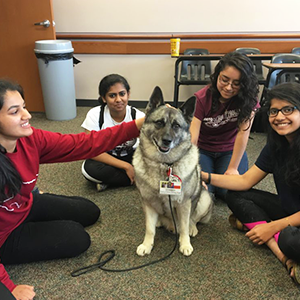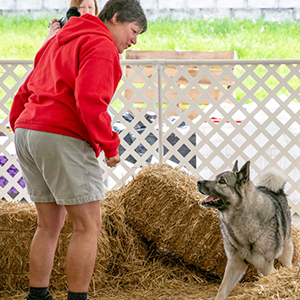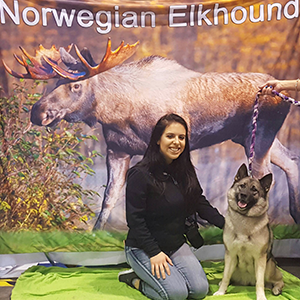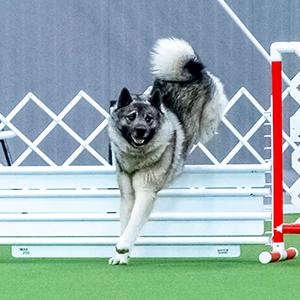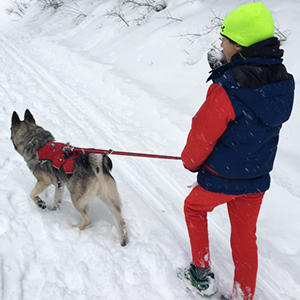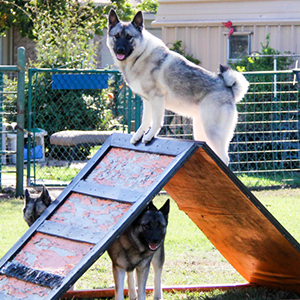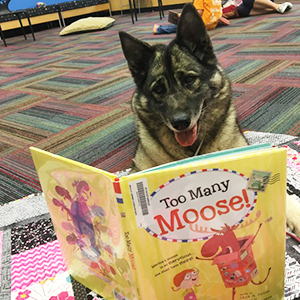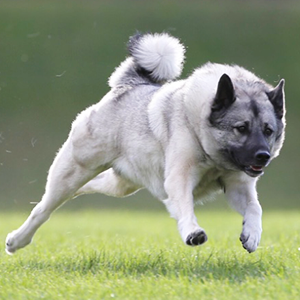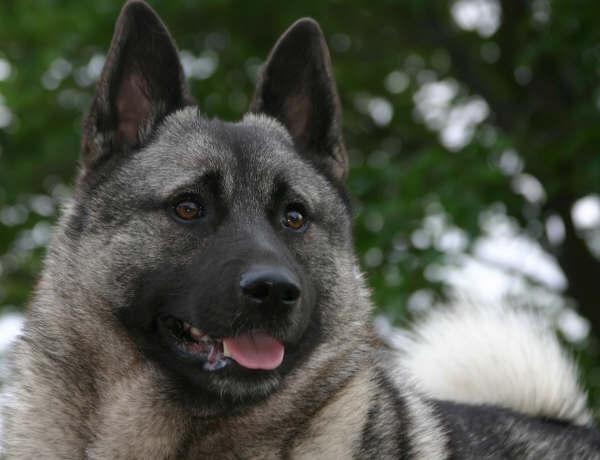
Norsk Elghund – Dog of the Vikings
The Norwegian Elkhound is bold and energetic, a hardy gray hunting dog known for his lush silver-gray coat and dignified but friendly demeanor.
In appearance, a typical northern dog of medium size and substance, square in profile, close coupled and balanced in proportions. The head is broad with prick ears, and the tail is tightly curled and carried over the back. The distinctive gray coat is dense and smooth lying.
As a hunter, the Norwegian Elkhound has the courage, agility and stamina to hold moose and other big game at bay by barking and dodging attack, and the endurance to track for long hours in all weather over rough and varied terrain.
The durable Elkhound is among Europe’s oldest dogs. They sailed with the Vikings and figure in Norse art and legend.
Did You Know?
A Norsk Elghund is really a Moose Dog!
Elg means Moose, and Hund means Dog… Elkhound was a translation error.
The Elkhound Hunter
The Norwegian Elkhound is a hunting dog. As such, he is a dog of function, not fashion. Nearly every breed standard is descriptive of the mental and physical features needed by an Elkhound to function in his unique manner of hunting in the northern climate.
An Elkhound is an independent hunter, free of direct command of his master, to silently trail moose and hold the game until the hunter can approach. He holds the game at bay by barking and being an annoyance rather than a threat. He usually approaches the moose head on, circling the quarry, offering himself as a target.
To avoid the lightning strikes of the moose, the dog must be able to jump instantly in any direction using his agility to escape harm’s way. The Elkhound is expected to be able to hold a moose at bay in this manner for over an hour.
Dogs are usually hunted singly or occasionally in pairs. Elkhounds are expected to have the stamina and agility to hunt day after day, in terrain that varies from marsh to hilly timber growth, and in weather conditions of cold rain, snow or sleet, and freezing temperatures.
When evaluating a dog, one should always ask, “Is this Elkhound capable of performing as a hunting dog?” An Elkhound is expected to be an active hunting dog to the age of ten or eleven years.
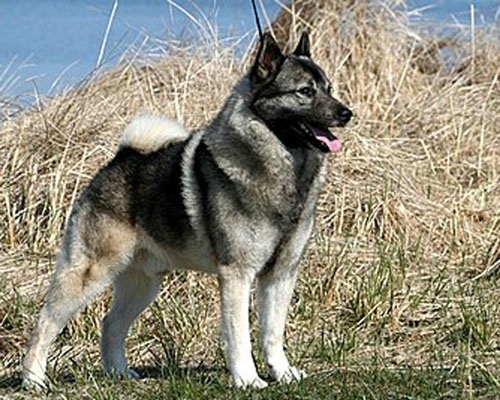
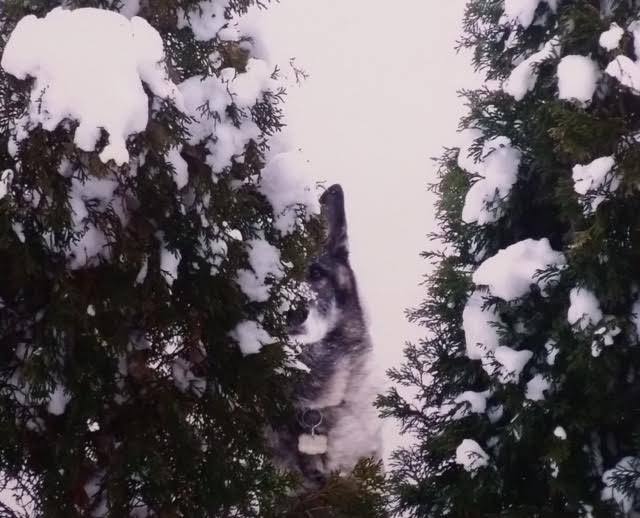
Fun Fact
Trademark Elkhound Tail is tightly curled over back so never wipes everything off your coffee table!
How Elkhounds Look
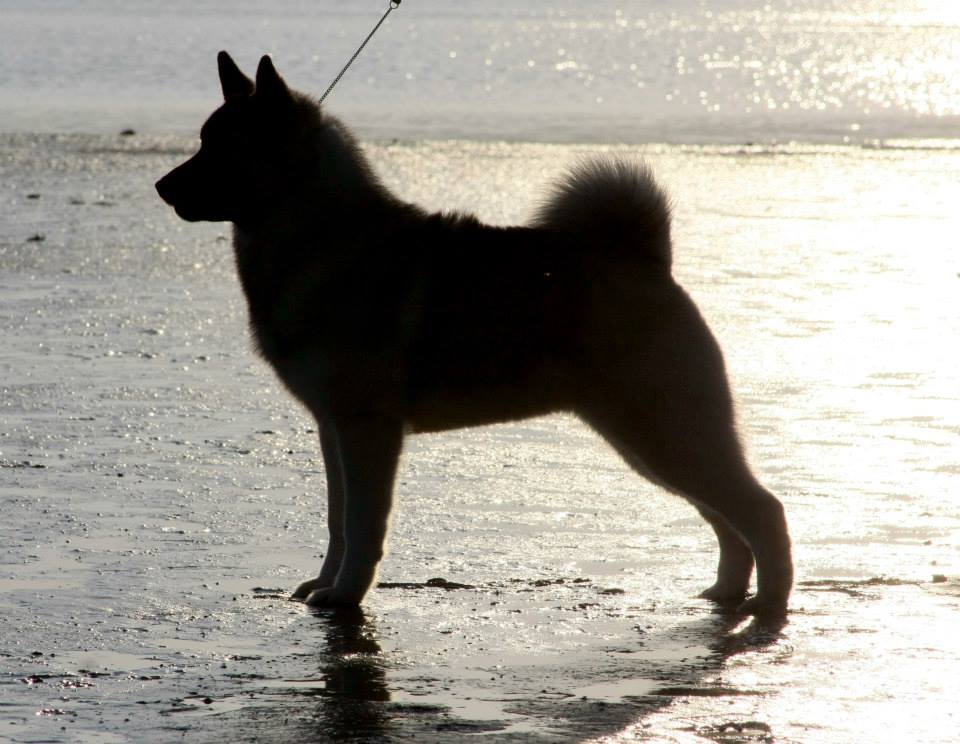
- Elkhounds are overall gray in color
- Distinctive grey coat is dense and lays smooth
- Square in profile
- Elkhounds are overall gray in color
- Medium in size 48-55 lbs
- Prick ears that are mobile and stand erect
- Tightly curled tail carried over back
The Norwegian Elkhound Illustrated Guide is the comprehensive textbook for breeders, owners and judges of Norwegian Elkhounds. Inside the AKC Breed Standard, drawings, history, and requirements for an elkhounds hunting abilities are detailed. Intimate knowledge of the Illustrated Guide is a must for any serious exhibitor, breeder, or judge.
The Norwegian Elkhound Breed Standard has been in existence for many years. Every breed has a standard – a document that is like a blueprint that details what that particular breed should look like – what is acceptable and what is not. The standard covers all aspects of a breed and guides in the selection of suitable breeding stock for future generations.
The Norwegian Elkhound Association of America Illustrated Guide contains visual aids that assist in clarifying for the reader what an Elkhound should be.
Living With Elkhounds
Elkhounds may seem like the ideal pet, but there are disadvantages to every breed. Listed below are areas you need to consider before you decide to share your life with a Norwegian Elkhound.
Background:
As the name implies, this dog originated in Norway and was used for hunting large game. A very rugged and robust dog built for endurance, bred and trained as a hunter and tracker, the Elkhound displays a keen and very acute sense of smell and hearing.
Temperament:
Temperament will vary from one individual to another, but an Elkhound is not normally aggressive by nature and can be relied upon not to attack without VERY extreme provocation. Normally friendly, even with strangers, his bear-like look, deep resounding bark, and large white teeth can discourage most unwanted visitors. An Elkhound can be protective, even possessive, of his human family and his property making him a commendable watch dog.
Exercise:
Elkhounds are very energetic and need to have consistent exercise daily (20-30 minutes twice a day) or they may have trouble adjusting to the calm housepet role expected by most owners.
Coat:
As is common with most northern dogs, the breed is double-coated — long coarse outer hair to shed rain, sleet and snow and soft wooly undercoat for insulation against the elements of nature. The undercoat sheds profusely twice a year, usually at six month intervals; guard hairs are shed approximately every other year. If you are a meticulous housekeeper, an Elkhound is not for you. The coat sheds most foreign substances with ease and the dog seems by instinct to keep himself clean. Regular grooming is advisable and an absolute necessity when shedding. A most unusual physical characteristic of the breed is the absence of “doggy odor”.
Training:
The Elkhound is a loving and good-natured dog, sensitive to praise and reproof without the necessity of physical punishment. It is amazing how much communication is possible through expressions, gestures, and voice. Remarkably intelligent, an Elkhound is also headstrong and independent. For this reason it is illogical to expect unquestioning obedience from an Elkhound. Left to his own devices, he can be prone to problematic behaviors. To consider an Elkhound, you must understand the role of training in the dog’s life and the need for it to be an ongoing process.
Health:
As it is not possible to produce genetically perfect humans, nor is it possible to produce genetically perfect dogs. The Elkhound is fortunate that it does not have the number of health problems present in many other breeds. Before you consider an Elkhound, be knowledgeable about the genetic defects that are most prevalent in the breed. Eye disorders (blindness), skeletal anomalies (hip dysplasia), urogenital conditions (renal disease), and skin ailments (cysts) are known to occur in the breed. It is possible to eliminate or reduce the incidence of these genetic problems by carrying out screening tests on all breeding stock.
Care & Maintenance:
Because of his long association with man and his deep devotion to his human family, an Elkhound thrives on love and attention. Housing needs are simple as he will prefer to live with you. Given a proper diet, reasonable exercise (30 minutes twice a day), and clean living conditions, the Elkhound is an extraordinarily maintenance free dog. Strong and vigorous, he will relish long walks or bicycling with his master. An Elkhound’s eyes rarely need care and likewise, his prick ears are usually trouble free. His feet require no special attention except regular clipping of his claws about every six weeks. The Elkhound, shown in his natural condition, requires no trimming or stripping — even for show purposes his whiskers need not be trimmed. Consider your lifestyle and household schedule — do you travel, do you work long hours, do children’s activities keep you busy? In other words, do you have the time to give an Elkhound the love and attention he needs.
Sports and Activities:
Agility, Barn Hunt, Therapy Dog, Obedience, Rally, Conformation (Dog Shows), Herding, Tracking, Scent Work, Hunting, Hiking, Camping, Skijoring…
Elkhounds want to be with you and your family.
Viking History
As rugged as the land from which he sprang, the Norwegian Elkhound was a cherished possession of his Viking masters, and he appears in many of the old sagas. Although he is known as the “Dog of the Vikings,” the Elkhounds earliest association with man dates from much earlier. In the famous Viste Cave at Jaeren in western Norway, archeological investigations brought to light a number of stone implements and bones dating from 5000 to 4000 BC.
From the present back through the centuries of recorded time, Elkhounds have been kept in Norwegian rural districts by farmers, herdsmen, and hunters to serve as watchdogs, guardians of flocks, and as trackers of big game: moose, reindeer, and bear. Outdoor jobs, all of them, in a rugged country and in a rigorous sub-arctic climate.
Included among these remains of an even earlier civilization were four skeletons of dogs, two of which were identified by Professor Brinchmann of the Bergen Museum as of definite Elkhound type. Thus even before the Viking Era, with primitive man the Elkhound had begun that long and staunch companionship with mankind. What his earliest duties were we can only surmise, but it is safe to say they involved the chase and the guardianship of his master’s crude belongings and primitive hearth.
In 1877 the Norwegian Hunters Association held its first dog show, and that year perhaps marks the beginning of interest in the Elkhound as a show dog. In ensuing years, records and stud books were established, a standard formulated, and as an increasing number of experienced breeders in Norway focused their attention on the breed, the Elkhound gradually came into his own as a show dog.
Interest in the breed spread to England, and the British Elkhound Society was formed in 1923 about seven years before a similar organization to sponsor the breed appeared in this country. The Norwegian Elkhound Association of America was organized in an informal way about 1930.
Subscribe To The Moose Dog Blog!
These mighty moosedogs would love to add a silver lining to your day!





